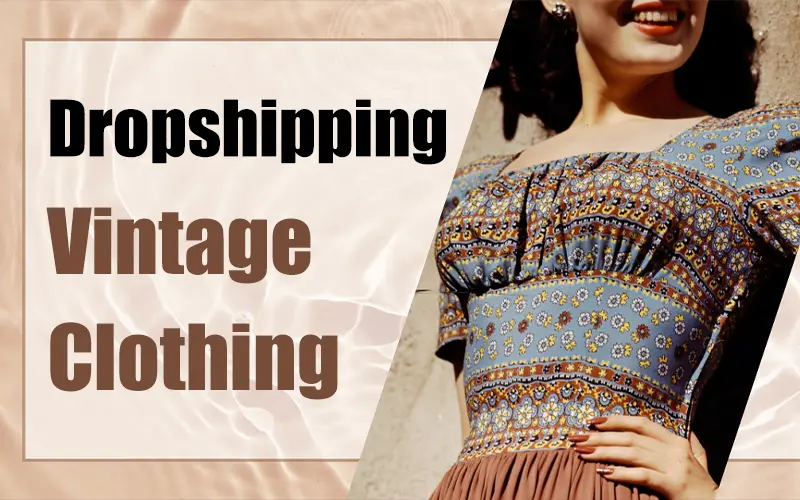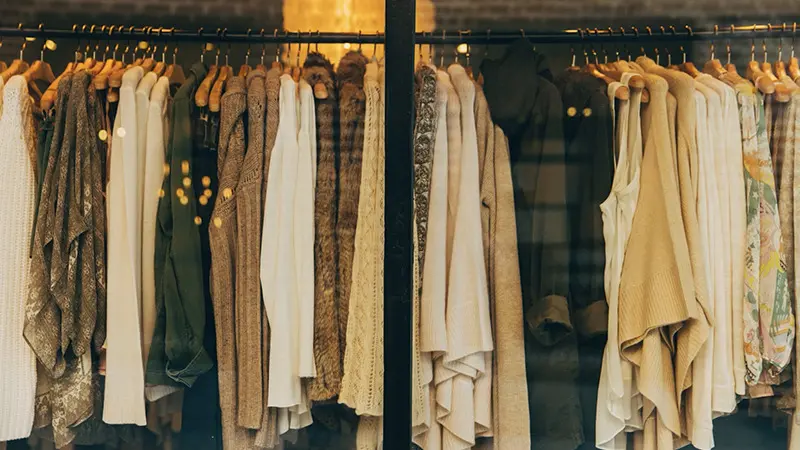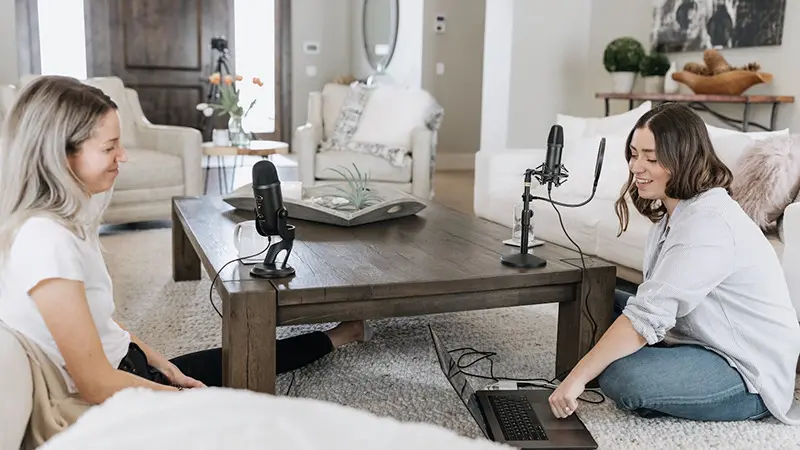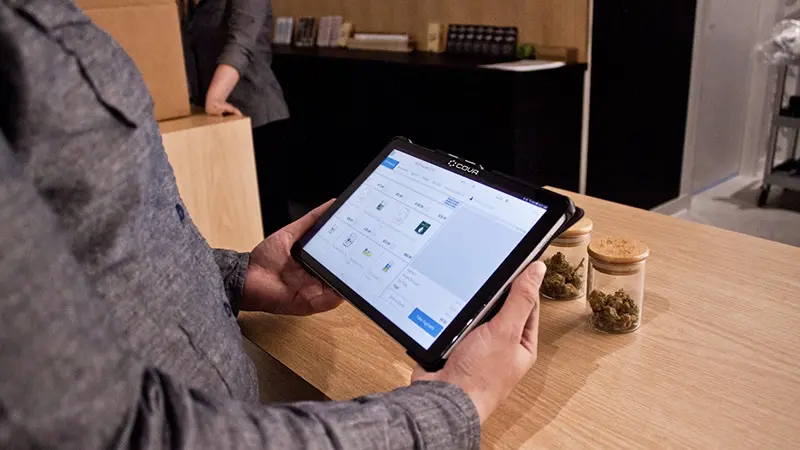Fashion works in cycles with traditional style returning like a fade. This influence has made the selling of vintage clothing a viable business prospect due to the twin factors of vintage clothing and eco-responsibility.
Regardless of whether you’re the CEO of a start-up business or a beginner in e-commerce, this guide will give you all that you need to succeed in the field of dropshipping vintage clothes in 2025. From the sourcing suppliers to actions involved in having a start for a dropshipping business, everything has been elaborated.
So, get ready to discover valuable rarities from the past and gain the status of an important figure in the sphere of fashion!

Why Dropship Vintage Clothing
The idea of dropshipping vintage clothing is quite appealing from a business perspective. Here are some reasons why you should consider dropshipping vintage clothing:
Growing Market
The market for buying and selling old garments is incredibly popular, mainly due to the continually growing appreciation for classics and historical fashion.
The market for vintage clothing is booming – currently valued at $24 billion and expected to grow at a rate of 15-20%. This growth pattern shows the increasing prospects within this area.
With the increasing interest in eco-fashion and unique clothing preferences among buyers, selling apparel through dropshipping offers a profitable opportunity to tap into these trends without the hassle of handling large inventories.
Market Trends and Influences
By tapping into these market trends and influences, dropshipping vintage clothing can be a highly attractive and profitable business model, appealing to a wide range of consumers who are influenced by current fashion movements and cultural trends.
- Retro Revival: One of the key drivers behind the vintage clothing boom is the ongoing retro revival. Many customers are mainly targeting 90s fashion, aiming to implement such styles in contemporary clothing. This sense of reliving is observed in both the younger generations, who are inclined toward the classics, as well as the older generations reverting to the style they had in their youth.
- Influence Endorsement: Social media and celebrities’ influence are other critical aspects that help determine what is in trend. Some influencers regularly share their looks with vintage clothes, causing their fans to dress the same way. Social media has become the birthing ground for retro fashion with influencers advertising rare vintage outfits. All in all, this social media hype is boosting sales in the vintage fashion market.
Diverse Sourcing Opportunities
The opportunity to get goods for vintage clothing dropshipping depends on various factors. Here are some prominent sources:
- Dropshipping Suppliers: Several suppliers specialize in clothing, offering a wide range of vintage pieces that can be seamlessly integrated into your dropshipping business. These suppliers are involved in managing the stock, packaging, and dispatching which relieves the marketer and salesperson.
- Thrift Stores: Thrift shops are stores that deal in second-hand wear, especially old wear. They offer a good opportunity to get a constant source of goods and creating partnerships with them can supply your Internet shop. Daily or frequent visits and good relations with the owners of the stores can land you some invaluable discoveries.
- Other Sources: Auctions, flea markets, and online marketplaces are also very good places where Second hand and vintage clothes can easily be bought. These platforms contain items that are harder to find and can make your store more attractive. To engage in these markets, one has to be perceptive of quality and legitimacy but the returns are handsome!

Higher Profit Margins
Vintage clothing often carries a higher perceived value compared to mass-produced items. This translates to the ability to set attractive price points that leave room for healthy profit margins.
Vintage, Antique, Retro: What’s the Difference?
Understanding the distinctions between vintage, antique, and retro clothing is essential for navigating the diverse world of fashion resale.
- Vintage Clothing: Typically refers to garments that are at least 20 years old but not more than 100 years old. Such items are patronized due to their rarity, quality, and the history of the piece on sale.
- Antique Clothing: This category consists of items that are more than one hundred years old. Antiquated clothes are far more scarce and due to their age, they tend to be more fragile. Often, these clothes find their own way with the collectors due to the fact that they are historically important and well-made.
- Retro Clothing: Retro encompasses garments that are produced in the current period to exhibit a look that belongs to previous decades. Original pieces are modern but are designed to resemble a particular period, which means that consumers can appreciate the designs of the past while enjoying brand-new clothes.
Model of Selling Vintage Clothing
When it comes to selling vintage clothing, there are two effective models:
- Partner with Dropshipping Suppliers: Collaborate with suppliers specializing in vintage-style clothing made from contemporary fabrics. These suppliers offer items that replicate the fashion of decades past, allowing you to provide a vintage look with the benefits of modern production. This model minimizes your involvement in inventory management and logistics, offering flexible options to vintage clothing enthusiasts who are confused by sizes, materials, and style.
- Sourcing from Thrift Stores: This hands-on approach involves curating authentic vintage pieces from local thrift stores. While it requires more manual work, this model can yield one-of-a-kind finds that attract collectors and fashion enthusiasts seeking authentic vintage items.
Steps to Dropship Vintage Clothing
Let’s explore some of the steps to dropship vintage clothing:
1. Market Research and Niche Selection
The foundation of any successful business lies in understanding your market. Dropshipping vintage clothing is no different. Dive deep into the world of vintage clothing with market research. Analyze current trends, popular eras, and styles resonating with today’s consumers. Resources like fashion blogs, industry reports, and social media platforms can provide valuable insights.
Keep in mind that the vintage market is very vast. So, to stand out, consider specializing in a particular era, style, or theme. Do you see a resurgence of 80s power dressing? Perhaps a focus on classic 50s silhouettes? Maybe a niche catering to vintage sportswear? A well-defined niche allows you to curate a focused collection and attract a targeted audience.
Lastly, don’t forget about competition analysis. While competition can be intimidating, it also offers valuable lessons. Research existing dropshippers and vintage clothing stores in your chosen niche. Analyze their product offerings, branding, and marketing strategies.
2. Find Reliable Suppliers
Suppliers are the backbone of your dropshipping business. Here, you’ll establish partnerships that ensure a steady flow of unique and high-quality vintage pieces for your customers.
- Dropshipping Suppliers: Working with dropshipping suppliers can eliminate the legwork of sourcing from individual suppliers. This offers advantages, such as convenience, quality control, etc.
- Thrift Stores: Regular visits to thrift stores can unearth hidden gems at competitive prices. However, this method requires time, dedication, and a keen eye for spotting quality pieces.
- Beyond the Store: The world of vintage extends far beyond brick-and-mortar stores. Consider exploring online marketplaces like Amazon, dedicated vintage platforms, estate auctions, and even local flea markets. These avenues offer the opportunity to source unique one-of-a-kind items that will make your collection stand out.
- Partnering with Pickers: “Pickers” are individuals specializing in sourcing vintage clothing supplies. By establishing a partnership, you can leverage their expertise and network to unearth fantastic finds that align with your niche. This option requires clear communication and well-defined selection criteria to ensure you receive the type of vintage pieces you envision for your store.
EPROLO is an invaluable asset for dropshipping vintage clothing. With EPROLO, you can access a broad range of high-quality vintage clothing. Without worrying about inventory management, you can focus on marketing and sale. EPROLO also provides robust customer service, ensuring your business maintains high customer satisfaction.

3. Set Up Your Online Store
Here, you have two main options: using online marketplaces like Amazon or building your own website. Each comes with its own advantages and disadvantages.
Online Marketplaces
Setting up a dropshipping store on online marketplaces has its own set of advantages and disadvantages. Here’s a detailed breakdown:
| Advantage | Disadvantage |
|---|---|
| Established Traffic: Platforms like eBay, Etsy, and Amazon boast established traffic with millions of active users, providing immediate access to a large audience. | Fees and Commissions: Listing fees and sales commissions can reduce profit margins. |
| Ease of Use: User-friendly interfaces make it easy to set up and start selling quickly. | Limited Branding: Customization options are often restricted. |
| Credibility and Trust: Known platforms offer built-in credibility, which can lead to higher conversion rates. | Competition: High competition makes it challenging to stand out. |
Build Your Own Website
Building your own website has its own set of advantages and disadvantages. Here’s a detailed breakdown:
| Advantage | Disadvantage |
|---|---|
| Brand Control: Complete control over your brand identity and website design. | Initial Investment: Upfront costs for domain, hosting, and possibly web development services. |
| No Marketplace Fees: Higher profit margins without listing fees and commissions. | Traffic Generation: Requires investment in marketing strategies to attract visitors. |
| Customer Relationships: Direct relationships with customers, enabling personalized marketing and loyalty programs. | Maintenance and Security: Ongoing effort and resources are needed to ensure site security and updates. |
4. Brand Development
Now that you’ve laid the groundwork, it’s time to build your brand identity. Your brand is more than just a logo; it’s the personality and story that sets you apart. Here’s how to cultivate a captivating brand for your vintage dropshipping business:
- Define Your Brand Story: What makes your store unique? What story do you want to tell your customers? Are you passionate about sustainable fashion? Do you focus on a specific era or style? Crafting a compelling brand story will resonate with your target audience and foster emotional connections.
- Develop a Cohesive Brand Aesthetic: Visuals are powerful. Develop a consistent aesthetic across your website, social media platforms, and marketing materials. This includes your logo, color palette, fonts, and photography style. A cohesive brand aesthetic creates a professional image and reinforces brand recognition.
- Cultivate a Community: Social media is your playground. Create engaging content, share interesting vintage finds, and highlight the stories behind the clothing. Collaborate with relevant influencers to broaden your reach, tap into their audience, and foster a community around your vintage dropshipping business.
5. Marketing Your Vintage Dropshipping Business
With a strong brand identity in place, it’s time to attract customers and generate sales. Here are some effective marketing strategies for your vintage dropshipping business:
- SEO: Use relevant keywords and meta details to make sure your store appears in search engine results when people search for vintage clothing.
- Social Media: Leverage visual-centric platforms like Instagram, Pinterest, and TikTok. Create visually appealing content that showcases your vintage collection and captures the essence of your brand. Utilize strategic hashtags to reach a wider audience and encourage user-generated content featuring your clothing.
- Email Marketing: Send engaging newsletters featuring new arrivals, special promotions, and vintage fashion tips. This fosters brand loyalty and encourages repeat customers.
- Paid Advertising: Run targeted ads to reach a highly relevant audience interested in vintage clothing.
- Collaborations: Partner with other vintage enthusiasts or complementary businesses to cross-promote and reach new audiences. This could involve influencer marketing, joint giveaways, or even pop-up events.
By implementing these marketing strategies, you’ll attract vintage lovers and build a thriving dropshipping business. Remember, consistency is key. Continuously evaluate and refine your marketing approach to ensure it delivers optimal results.

6. Managing Orders and Customer Service
Efficient order management and customer service help maintain customer satisfaction and foster loyalty. Here’s how to handle these aspects effectively:
- Order Management: Use a reliable e-commerce platform or dropshipping software to streamline order processing. Automation tools can help manage inventory, track orders, and update customers on their order status in real time. Ensure your suppliers provide timely shipping and accurate tracking information to avoid delays and confusion.
- Customer Service: Be responsive and empathetic. Address inquiries and resolve issues promptly to maintain a positive reputation.
- Clear Policies: Establish clear and transparent policies for shipping, returns, and exchanges. These policies must be accessible on your website and communicated to customers at the point of purchase. Clear policies build trust and help manage customer expectations.
7. Scale Your Business
Once your vintage dropshipping business is running smoothly, it’s time to focus on scaling up to increase revenue and market presence.
- Expand Product Range: Introduce new product lines and expand your inventory to attract a broader audience. Consider adding related accessories or branching into different vintage styles and eras.
- Diversify Marketing Channels: Invest in diverse marketing strategies to reach more potential customers. Explore influencer collaborations, affiliate marketing, and new social media platforms to expand your reach.
- Optimize Operations: Improve operational efficiency by automating repetitive tasks and streamlining workflows. Invest in advanced dropshipping software that offers more robust features for inventory management, order processing, and customer service.
- International Expansion: Consider expanding your business internationally. Research global markets to identify regions with high demand for vintage clothing. Adjust your marketing strategies to cater to different cultural preferences and purchasing behaviors.
- Build a Community: Foster a loyal customer base by creating a community around your brand. Engage with customers through social media, host events, and offer exclusive perks to loyal customers. A strong community can drive word-of-mouth marketing and repeat sales.
- Monitor Performance: Regularly analyze your business performance using key metrics. Use this data to make informed decisions and identify areas for improvement.

Tips for Success in Dropshipping Vintage Clothing
Want to set your vintage dropshipping business up for success? The following strategies will help build a strong brand, attract loyal customers, and create a thriving online presence for dropshipping vintage clothing like a pro.
1. Invest in High-Quality Photography
High-quality photography is essential in the vintage clothing business. Your customers can’t physically touch or try on the clothes, so clear, detailed images are crucial to convey the quality and appeal of each piece.
- Multiple Angles: Capture each item from multiple angles to showcase its features, details, and condition. Include close-ups of unique elements like buttons, stitching, and patterns.
- Professional Lighting: Use good lighting to highlight the true colors and textures of the fabric. Natural light or soft studio lighting works best to avoid harsh shadows.
- Styled Shoots: Consider styled photoshoots to show how the items can be worn. This will make your products more appealing and help customers visualize how to incorporate vintage pieces into their wardrobes.
2. Provide Vintage Clothing Combination Suggestions
Help your customers see the potential of each piece by providing vintage clothing combination suggestions. For customers who don’t know how to make a combination, it’s a potential cross-selling chance. This not only enhances the shopping experience but also has the potential to increase sales through a cross-selling strategy.
- Styling Tips: Offer styling tips and outfit ideas on your product pages. Suggest how a vintage blouse can be paired with modern jeans or how a 1950s dress can be accessorized for a contemporary look.
- Lookbooks: Create lookbooks or fashion guides featuring your vintage items. These can be seasonal, themed, or based on different fashion eras, providing inspiration and encouraging customers to buy multiple pieces.
- Mix and Match: Highlight versatile items that can styled with other pieces in your collection. This helps customers see the value and versatility of your products.
3. Curate Your Inventory Carefully
Curating a high-quality inventory is key to building trust and loyalty with your customers. Vintage buyers expect authenticity and well-preserved items.
- Excellent Condition: Ensure each item is in excellent condition, free from significant flaws, and well-preserved. Repair minor issues, clean the items, and provide accurate descriptions of their condition.
- Authenticity Verification: Verify the authenticity of vintage pieces. Research the history and era of the items to accurately represent them to your customers. Knowledge of different fashion periods and designer labels adds credibility to your business.

4. Leverage Social Media
Social media is the perfect place to promote your vintage clothing business and engage with your audience.
- Visual Platforms: Use visual platforms like Instagram and Pinterest to showcase vintage fashion. Share high-quality images, styling tips, and behind-the-scenes content to build a strong visual presence.
- Influencer Partnerships: Partner with fashion influencers who can help promote your vintage pieces to their audience. Influencers lend credibility and expand your reach to potential customers who trust their recommendations.
- Community Engagement: Take the time to engage with your target audience. Respond to comments, participate in conversations, and use hashtags to join relevant discussions. Hosting giveaways, contests, and collaborations can also boost engagement and attract new followers.
- Posting: Use a mix of content types, such as product photos, customer testimonials, and fashion inspiration, to keep your feed interesting and dynamic.
Wrap-Up
The realm of dropshipping vintage clothing presents a wealth of opportunities for budding business owners. By dropshipping vintage clothing, you can take advantage of a thriving industry while providing environmentally friendly fashion choices.
We have covered the steps to navigate this thrilling endeavor, from conducting market analysis and selecting a niche to establishing your brand, promoting your products, and expanding your enterprise.
Keep in mind that success hinges on finding the best suppliers and developing a brand image. So, are you prepared to embark on your journey as an expert in dropshipping?







